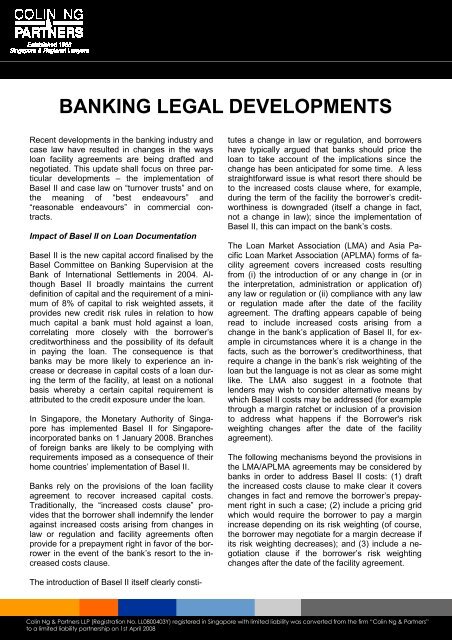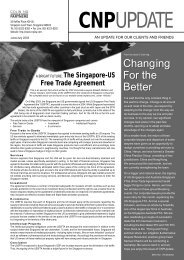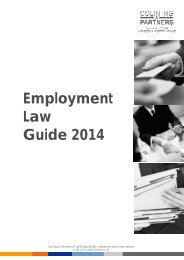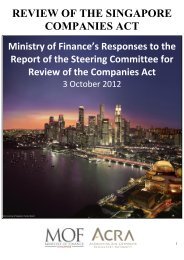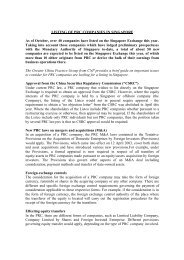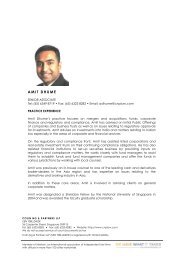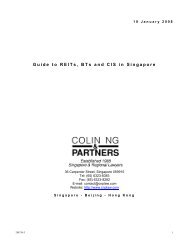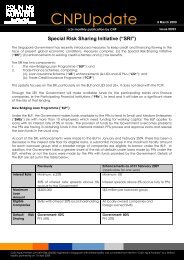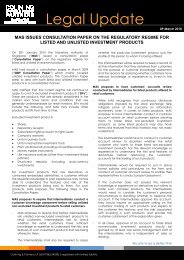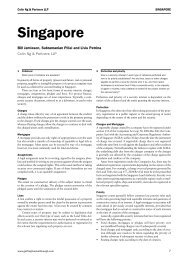Bill's article - Colin Ng and Partners
Bill's article - Colin Ng and Partners
Bill's article - Colin Ng and Partners
- No tags were found...
You also want an ePaper? Increase the reach of your titles
YUMPU automatically turns print PDFs into web optimized ePapers that Google loves.
BANKING LEGAL DEVELOPMENTS<br />
Recent developments in the banking industry <strong>and</strong><br />
case law have resulted in changes in the ways<br />
loan facility agreements are being drafted <strong>and</strong><br />
negotiated. This update shall focus on three particular<br />
developments – the implementation of<br />
Basel II <strong>and</strong> case law on “turnover trusts” <strong>and</strong> on<br />
the meaning of “best endeavours” <strong>and</strong><br />
“reasonable endeavours” in commercial contracts.<br />
Impact of Basel II on Loan Documentation<br />
Basel II is the new capital accord finalised by the<br />
Basel Committee on Banking Supervision at the<br />
Bank of International Settlements in 2004. Although<br />
Basel II broadly maintains the current<br />
definition of capital <strong>and</strong> the requirement of a minimum<br />
of 8% of capital to risk weighted assets, it<br />
provides new credit risk rules in relation to how<br />
much capital a bank must hold against a loan,<br />
correlating more closely with the borrower’s<br />
creditworthiness <strong>and</strong> the possibility of its default<br />
in paying the loan. The consequence is that<br />
banks may be more likely to experience an increase<br />
or decrease in capital costs of a loan during<br />
the term of the facility, at least on a notional<br />
basis whereby a certain capital requirement is<br />
attributed to the credit exposure under the loan.<br />
In Singapore, the Monetary Authority of Singapore<br />
has implemented Basel II for Singaporeincorporated<br />
banks on 1 January 2008. Branches<br />
of foreign banks are likely to be complying with<br />
requirements imposed as a consequence of their<br />
home countries’ implementation of Basel II.<br />
Banks rely on the provisions of the loan facility<br />
agreement to recover increased capital costs.<br />
Traditionally, the “increased costs clause” provides<br />
that the borrower shall indemnify the lender<br />
against increased costs arising from changes in<br />
law or regulation <strong>and</strong> facility agreements often<br />
provide for a prepayment right in favor of the borrower<br />
in the event of the bank’s resort to the increased<br />
costs clause.<br />
tutes a change in law or regulation, <strong>and</strong> borrowers<br />
have typically argued that banks should price the<br />
loan to take account of the implications since the<br />
change has been anticipated for some time. A less<br />
straightforward issue is what resort there should be<br />
to the increased costs clause where, for example,<br />
during the term of the facility the borrower’s creditworthiness<br />
is downgraded (itself a change in fact,<br />
not a change in law); since the implementation of<br />
Basel II, this can impact on the bank’s costs.<br />
The Loan Market Association (LMA) <strong>and</strong> Asia Pacific<br />
Loan Market Association (APLMA) forms of facility<br />
agreement covers increased costs resulting<br />
from (i) the introduction of or any change in (or in<br />
the interpretation, administration or application of)<br />
any law or regulation or (ii) compliance with any law<br />
or regulation made after the date of the facility<br />
agreement. The drafting appears capable of being<br />
read to include increased costs arising from a<br />
change in the bank’s application of Basel II, for example<br />
in circumstances where it is a change in the<br />
facts, such as the borrower’s creditworthiness, that<br />
require a change in the bank’s risk weighting of the<br />
loan but the language is not as clear as some might<br />
like. The LMA also suggest in a footnote that<br />
lenders may wish to consider alternative means by<br />
which Basel II costs may be addressed (for example<br />
through a margin ratchet or inclusion of a provision<br />
to address what happens if the Borrower's risk<br />
weighting changes after the date of the facility<br />
agreement).<br />
The following mechanisms beyond the provisions in<br />
the LMA/APLMA agreements may be considered by<br />
banks in order to address Basel II costs: (1) draft<br />
the increased costs clause to make clear it covers<br />
changes in fact <strong>and</strong> remove the borrower’s prepayment<br />
right in such a case; (2) include a pricing grid<br />
which would require the borrower to pay a margin<br />
increase depending on its risk weighting (of course,<br />
the borrower may negotiate for a margin decrease if<br />
its risk weighting decreases); <strong>and</strong> (3) include a negotiation<br />
clause if the borrower’s risk weighting<br />
changes after the date of the facility agreement.<br />
The introduction of Basel II itself clearly consti-<br />
<strong>Colin</strong> <strong>Ng</strong> & <strong>Partners</strong> LLP (Registration No. LL0800403Y) registered in Singapore with limited liability was converted from the firm “<strong>Colin</strong> <strong>Ng</strong> & <strong>Partners</strong>”<br />
to a limited liability partnership on 1st April 2008
Turnover Trust Clause<br />
A turnover trust is created when a junior creditor<br />
undertakes that when it receives funds from the<br />
borrower, the junior creditor will hold such funds in<br />
trust for <strong>and</strong> pay the same to the senior creditor.<br />
In the 2007 draft of the LMA facility agreement, a<br />
turnover trust was inserted in the guarantee<br />
clause which obliges the guarantor to turn over to<br />
the bank/s any payment received by it in relation<br />
to any guarantee payment made by it, until the<br />
bank/s have been paid in full. This is intended for<br />
the protection of the proceeds in case of the insolvency<br />
of the guarantor.<br />
An issue frequently raised in the context of such a<br />
trust is whether or not it constitutes a charge. If<br />
so, it could be required to be registered under<br />
Section 131 of the Singapore Companies Act<br />
(Cap 50), otherwise, it would be void against the<br />
liquidator <strong>and</strong> any creditor of the company, <strong>and</strong><br />
the guarantor could well resist the turnover trust<br />
provision on the basis that it offended negative<br />
pledges it had given.<br />
In SSSL Realisations (2002) Ltd v AIG Europe<br />
(UK) Ltd ([2006] EWCA, [2006] All ER (D) 98), it<br />
was held that a turnover trust is not a charge, if<br />
drafted so as to create a trust only to the extent of<br />
the amount owed <strong>and</strong> not the full amount of the<br />
payment received. The case is helpful in clarifying<br />
the position so that a borrower should have<br />
less objection, in principle, to agreeing that, after<br />
making a guarantee payment, it will hold any recoveries<br />
under a turnover trust.<br />
sman International LLC [2007] EWHC 292<br />
(Comm), it was held that an obligation to use reasonable<br />
endeavours to achieve the aim requires a<br />
party to take one reasonable course, not all of<br />
them, whereas an obligation to use best endeavours<br />
requires a party to take all the reasonable<br />
courses he can. On this basis, an obligation to use<br />
“all reasonable endeavours” can be considered<br />
something more than a simple obligation to use<br />
“reasonable endeavours”. It was held further that,<br />
where the contract actually specifies the steps to<br />
be taken in the exercise of reasonable endeavours,<br />
those steps will have to be taken, even if that could<br />
involve a disadvantage to a party's commercial interests.<br />
Banks may want to consider the following points in<br />
negotiating <strong>and</strong> drafting “endeavours” clauses: (1)<br />
to avoid uncertainty, “must” or “shall ensure” should<br />
be used instead of “endeavours” to describe an<br />
absolute obligation to perform a contractual term;<br />
<strong>and</strong> (2) if the use of “endeavours” is agreed upon,<br />
objective criteria against which the endeavours<br />
can be measured should be provided.<br />
For more information, you are welcome to contact:<br />
Bill Jamieson<br />
Partner<br />
Tel: 6349 8621<br />
Email: bjamieson@cnplaw.com<br />
Best Endeavours <strong>and</strong> Reasonable Endeavours<br />
The obligations in a loan facility agreement are<br />
often qualified by a qualitative threshold – that<br />
they are subject to the borrower’s using its best<br />
endeavours or reasonable endeavours.<br />
In Travista Development Pte Ltd v Tan Kim Swee<br />
Augustine & Others [2007] SGCA 57, it was held<br />
that a best endeavours obligation is an undertaking<br />
to “do everything reasonable in good faith with<br />
a view to obtaining the required result within the<br />
time allowed.” The determination of compliance<br />
with such an undertaking would involve a factual<br />
analysis of the circumstances of the case.<br />
In Rhodia International Holdings Limited v. Hunt -<br />
COLIN NG & PARTNERS LLP<br />
LLP Registration No.: LL0800403Y<br />
36 Carpenter Street, Singapore 059915 Tel: (65) 6323-8383 • Fax: (65) 6323-8282 • Website: http://www.cnplaw.com


